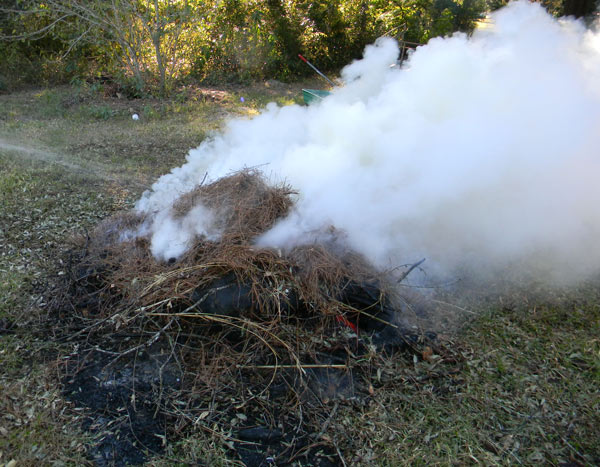My friend Rick shares his story of accidental backyard biochar success:
Back in 2008, the year I first moved to the country, I was doing some bonfires on adjoining extended family land because there was just too much dead wood all over the place. I took the tractor with the front-end loader over there and pushed it all together into a pile, then I pushed tons of oak leaves around the edges of the pile. My intended strategy had been to start the fire, let it burn down to some semblance of completion while soaking all the leaves with the hose, and then I would push the leaves onto the fire to smother it, and create some charcoal in the process.
I figured the fire would be out in a few hours. I had even filled up 10 5-gal buckets in a circle around it to help put it out. So once I had major burndown, where the 8-ft pile was only a couple feet off the ground, I wet everything thoroughly, and then piled the wet leaves all over it, and I spent another hour wetting it down. By then it was getting dark so I just made sure the ground was wet all around, and I drove the tractor back home.
Next morning I went over to see, and there were still tons of small plumes of smoke coming up through the leaves, and what had been a 2-ft pile was now a 1-ft pile. I wet everything thoroughly for another couple hours and figured I would scoop up all the ashes the next day.
It took 3 days for everything to finally cool down! And by then the leaves had mostly disintegrated into this black mass mixed with the charcoal and ashes. And it looked… like really good soil. I honestly had no idea, but I had heard about old-time farmers mixing ashes in soil so I figured I would give it a try. I loaded up the trailer with what must have been at least a ton of wet charcoal and leaves, and carted it all back to my place and made 4 long garden beds with it. And the stuff that grew in there was just amazing. Then my neighbor gave me a magazine article about “biochar” and the ancient Amazonians and said “see Rick, this is what you were doing.”
Poor sand and clay seem to really benefit from biochar. Rick was the one who originally introduced me to the idea of terra preta, which has now bloomed into an obsession.
And 06a09 comments on our recent video:
I’ve wondered if this type of soil was created as a result of the accumulation of slash and burn cycles. There is a short documentary on YouTube by the channel ‘odyssey earth’ about the Maya. It explains that people would slash and burn areas of forest on 3 year cycles. Year 1 they would slash burn and plant annuals (corn beans squash etc). They would then allow saplings to regrow naturally in the area they had cut, selecting for useful trees/shrubs, and culling undesirable ones. They would let it regrow until the area was too shady and then move onto the next patch of ground. Over thousands of years is it not possible that this could slowly accumulate a charcoal/carbon layer after returning to the same area again and again? (Rather than digging a hole and doing it all at once). They could have burned the area and then threw their waste onto it too. That would explain the pottery etc. It also explains the whole “the Amazon is man made” thing.
This is almost certainly part of it. There is a place for “slash and burn.”
And carrotspaghetti236 comments on the same video:
Okay, if you are faint hearted skip my contribution. I butcher at least 6 roosters yearly, catching blood in a bucket, keeping said bucket as a fetid fertilizer solution; in the winter, being in zone 5, I use a woodstove and take a little wood out before its fully burned, and crumble the charred wood into the blood bucket and let it fester all winter in the mud room where it won’t freeze and break the bucket. My sandy soil has been pitiful, but where I amended the garden bed this spring with my fetid bloody char solution, I have had tremendously increased production.
Gross, but effective!
When we slaughter pigs this fall I’ll have to remember that.


1 comment
The problems my parents have encountered with burn… well… piles, we haven’t tried a pit yet… is that something about it seems to germinate dormant thistle seeds.
Comments are closed.